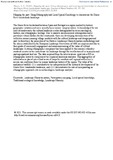Mostrar el registro sencillo del ítem
Mapping the past: using ethnography and local spatial knowledge to characterize the Duero river borderlands landscape
| dc.creator | Hearn, Kyle Patrick | es_ES |
| dc.date.accessioned | 2021-09-03T08:46:04Z | |
| dc.date.available | 2023-02-01T00:00:14Z | |
| dc.date.issued | 2021 | |
| dc.identifier.issn | 0743-0167 | |
| dc.identifier.uri | https://hdl.handle.net/2454/40405 | |
| dc.description.abstract | The Duero River borderland between Spain and Portugal is a region marked by historic geographic isolation and more recently by economic marginalization. Acknowledged for not only its biodiversity, the cultural landscape is also distinguished by its archaeological, historic, and ethnographic heritage. Due to massive socioeconomic outmigration and a prevalent cultural disdain for the countryside, there is a developing disconnection of the collective memory among village residents with the cultural landscape and its agropastoral past. In this study, the principles of the Historic Landscape Characterization methodology and the ideals established by the European Landscape Convention of 2000 are implemented due to their goals of community engagement and awareness raising of the value of cultural landscapes. A strong ethnographic component has been applied to this research whereby residents in interviews characterize the landscape through the recollection of its toponyms and past agropastoral land use. The data acquired from the interviews are input into a GIS as ethnographic layers to complement the empirical landscape analyses. This aggregation of information is placed into a final series of maps for residents and regional authorities to access, use, and learn from the unique landscape history of the region. The value of the analysis is twofold: (1) it contributes to the interpretation of the historical development of the Duero River transborder landscape; and (2) it demonstrates the role of incorporating an ethnographic approach into an archaeological landscape analysis. | en |
| dc.description.sponsorship | The research for this project was undertaken with assistance and funding from the research project titled, Paisajes Rurales Antiguos del Noroeste Peninsular: Formas de Dominación Romana y Explotación de Recursos, CORUS (HAR 2015-64632-P; MINECO/FEDER) of the Social Structure and Territory Landscape Archaeology (EST-AP) group of the Spanish National Research Council Center for Human and Social Sciences (CSIC–CCHS) in Madrid, Spain and a pre-doctoral fellowship award from Universidad Pública de Navarra with the Institute for Advanced Social Research (I-COMMUNITAS). | en |
| dc.format.extent | 44 p. | |
| dc.format.mimetype | application/pdf | en |
| dc.language.iso | eng | en |
| dc.publisher | Elsevier | en |
| dc.relation.ispartof | Journal of Rural Studies 82 (2021) 37-53 | en |
| dc.rights | © 2021 Elsevier Ltd. This manuscript version is made available under the CC-BY-NC-ND 4.0 | en |
| dc.rights.uri | http://creativecommons.org/licenses/by-nc-nd/4.0/ | |
| dc.subject | Landscape characterization | en |
| dc.subject | Landscape memory | en |
| dc.subject | Local spatial knowledge | en |
| dc.subject | Participatory mapping | en |
| dc.subject | Traditional ecological knowledge | en |
| dc.title | Mapping the past: using ethnography and local spatial knowledge to characterize the Duero river borderlands landscape | en |
| dc.type | info:eu-repo/semantics/article | en |
| dc.type | Artículo / Artikulua | es |
| dc.contributor.department | Ciencias Humanas y de la Educación | es_ES |
| dc.contributor.department | Giza eta Hezkuntza Zientziak | eu |
| dc.rights.accessRights | info:eu-repo/semantics/openAccess | en |
| dc.rights.accessRights | Acceso abierto / Sarbide irekia | es |
| dc.embargo.terms | 2023-02-01 | |
| dc.identifier.doi | 10.1016/j.jrurstud.2021.01.024 | |
| dc.relation.projectID | info:eu-repo/grantAgreement/MINECO//HAR2015-64632-P/ES/ | en |
| dc.relation.publisherversion | https://doi.org/10.1016/j.jrurstud.2021.01.024 | |
| dc.type.version | info:eu-repo/semantics/acceptedVersion | en |
| dc.type.version | Versión aceptada / Onetsi den bertsioa | es |
| dc.contributor.funder | Universidad Pública de Navarra / Nafarroako Unibertsitate Publikoa | es |



